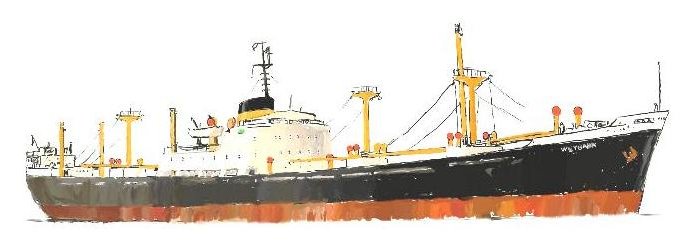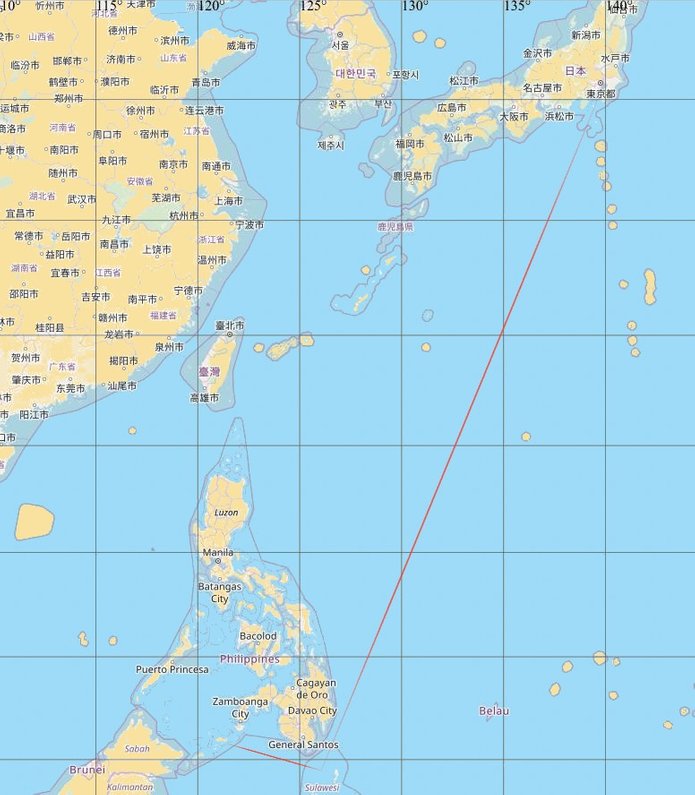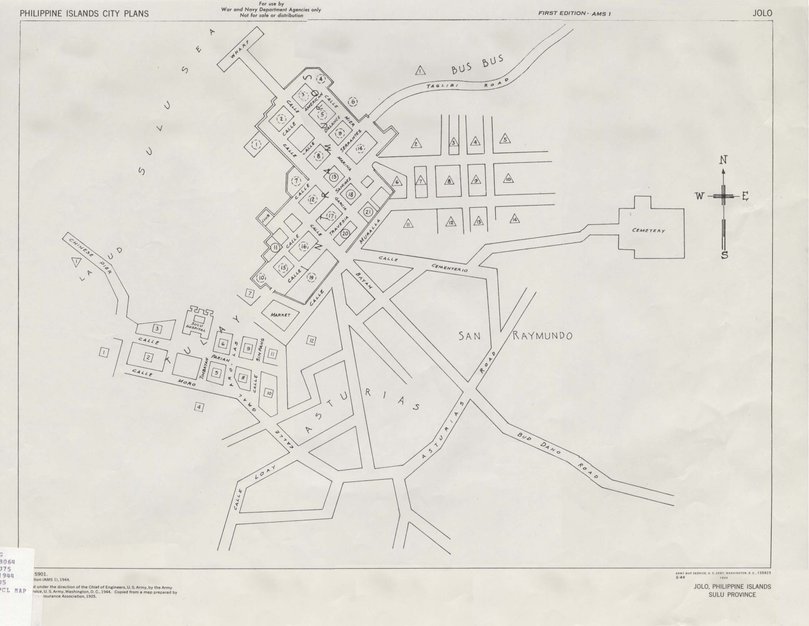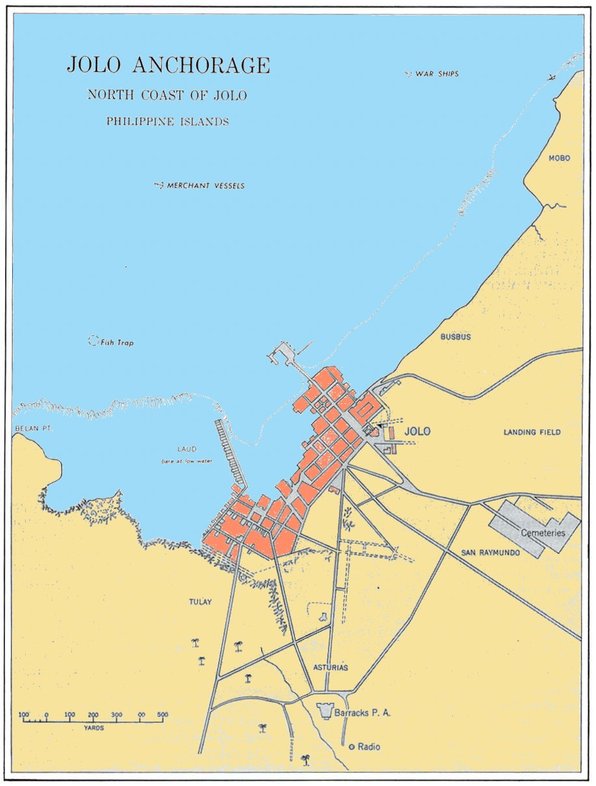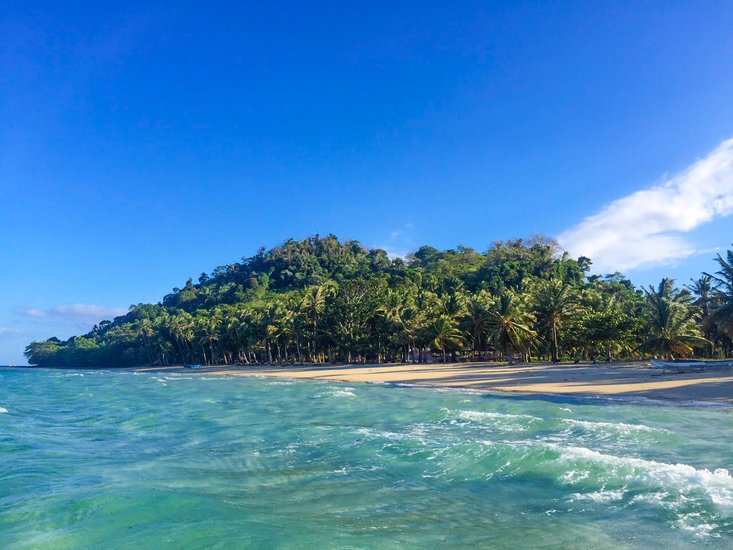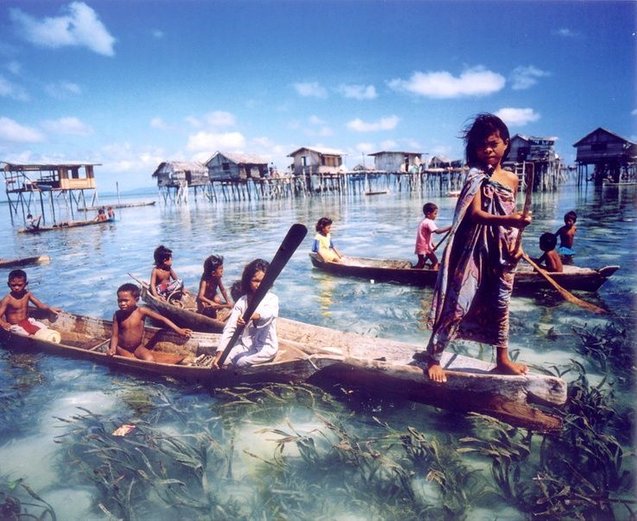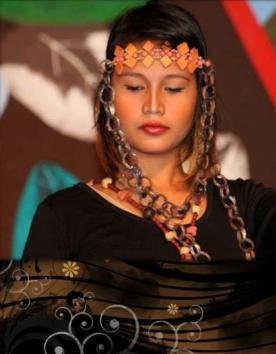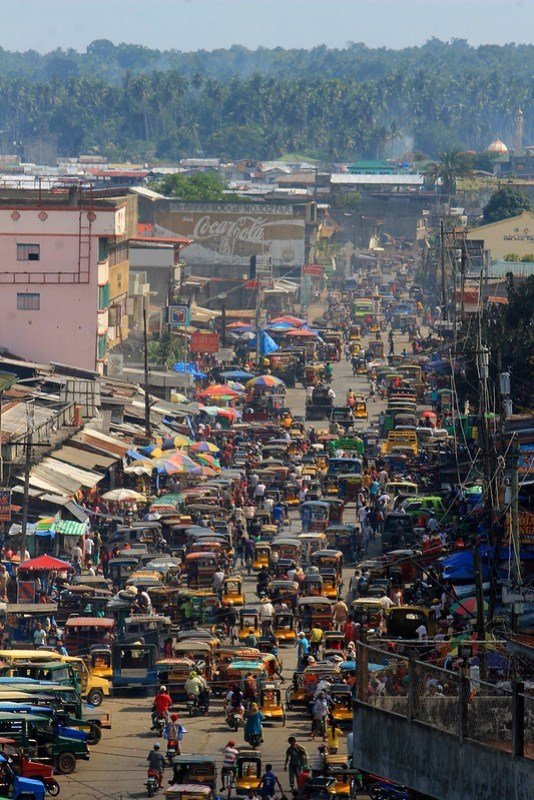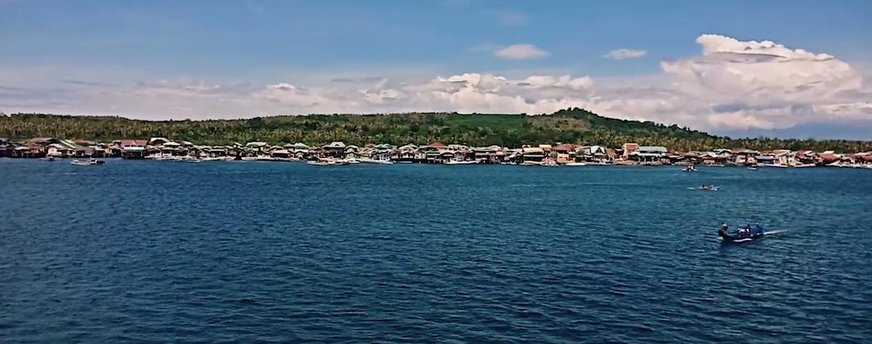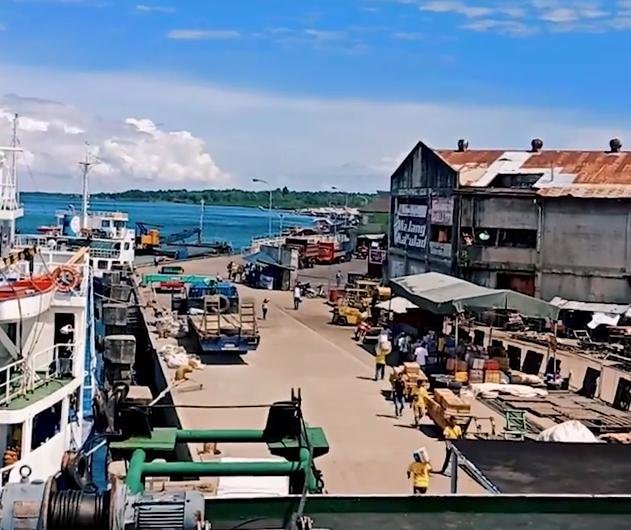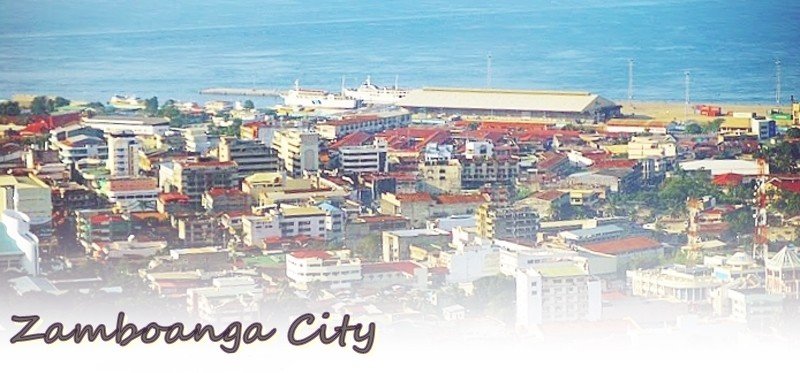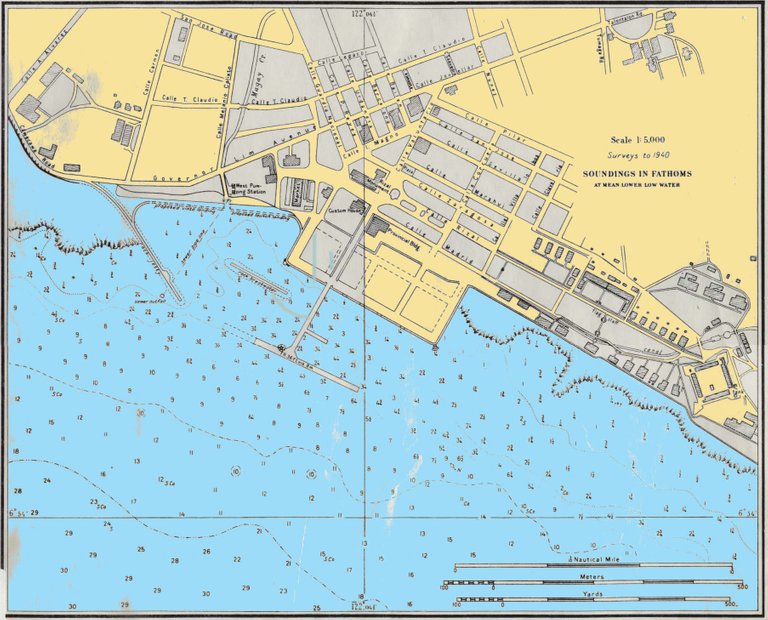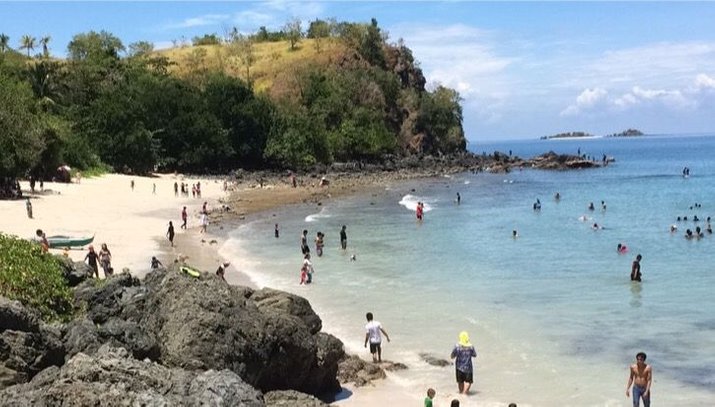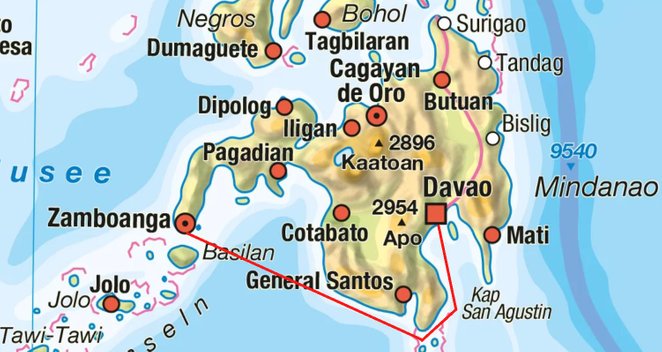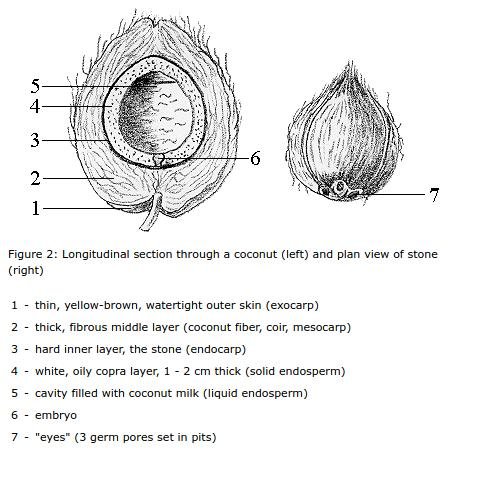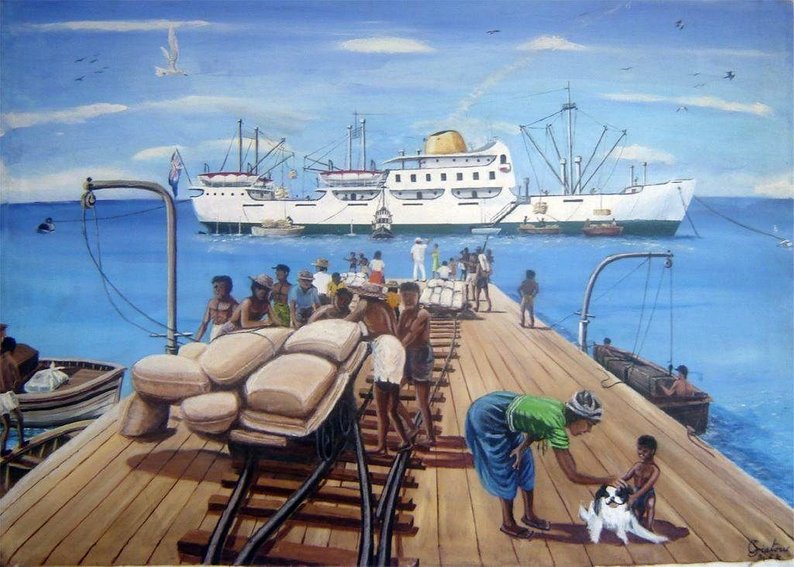Mandalay
M.V. Weybank - Chapter 13
The Philippines
The Mercator chart above shows lines of latitude and longitude at 5° intervals forming a grid. Our „Dead Reckoning“ (DR) course from Yokohama to our destination Jolo Island is drawn in red.
The total distance to is close to 2324 sm (4300 km) which takes us almost 7 days sailing time before we arrive at Jolo in the Philippines. Jolo is a small volcanic island in the Sulu Sea, one of a group of islands that, like pearls in a necklace, lace down to Sabah in Borneo. As far as I can remember our trip down to Jolo was uneventful, apart from the fact that the temperature was rising day by day the further southwest we sailed.
Our arrival at the port/town Jolo (which bears the same name as the island itself) on a beautiful sunny afternoon was memorable. An azure sky, deep blue sea – we picked up a pilot on our approach. The coastline/waterfront of Jolo town is tidal, in this case meaning that when the tide runs out the waterfront becomes „bare“ i.e. no water. When the tide ran in, the water depth was still too shallow for a ship to cross without running aground. Which is why many years ago a pier had been built from the town centre to deeper water just outside the tidal range. It was a small „one ship“ pier.
As we got nearer to the pier our ship turned broadside to it (at least that was the intention). There was no tug (I never saw one the whole time we were there) to assist us in manouvering. I stood on the starboard side boatdeck enjoying the scenery when I suddenly realised that not only were we approaching too fast, we were not broadside either. Our stern was much closer to the pier than our bow.
Until this point I had not only been enjoying the ambient scenery but had also been watching labourers who were in the process of constructing an extension to the pier, which happened to be from my point of view at the right hand side of the existing pier – the point in which our stern was rapidly swinging towards. I remember hearing the frantic ringing of the engine room telegraph in the wheelhouse and bending over the rail I saw and heard the pilot screaming at the people on the pier. Pulling my eyes back to the pier extension I witnesed a „Keystone Cops“ type action movie.
The extension pier‘s reinforced concrete support piles had been driven some time previously into the seabed and the labourers were now in the process of building the pier surface. Pandemonium as shovels, wheelbarrows and cement, preceded by labourers flew in the air. Some of the workers tried to run towards the safety? of the existing pier but the intelligent ones all dived into the sea from the pier side or edge facing away from our „Angriff“ (attack).
Like in a slow motion movie we relentlessly got closer and closer and then – CRUMMP – the piers concrete piles resisted with bravery. They all in their resistance gave way but did not collapse – they were just „bent“ backwards, however the pier‘s surface didn‘t appreciate bending and in protest collapsed into the water below. The only good thing about this (from our point of view) was that the pier‘s piles had broken our momentum – we floated „in situ“ until someone more intelligent than the rest of us threw a line ashore. I never heard how much this cost the Bank Line back in the UK- (top secret) - it must have been a „pretty penny“. Although we had a Philippino pilot aboard, it is always the Master (ship‘s Captain) who legally takes the blame. Who knows for sure? Maybe the ship‘s engine/propellor/rudder didn‘t respond quickly enough to the controls. At least we had made our mark, like an alleycat (or a dog p…..g against a lampost) in true Glasgow Rangers style: „We are the People“ (Scots Gaelic translation – Wee arrow peepel) – not for nothing is Glasgow painted on our stern!
Below is a US Army Map of Jolo from 1944. Take a look at the pier, it has no extension.
The next map is also of Jolo but drawn in 1993. Note the pier extension MK II, rebuilt after we had demolished MK I in 1969!
Next morning alongside we were having our breakfast in the salon when all of a sudden we heard a BOOM! which caused or whole ship to vibrate/undulate (how else to describe it?). We all rushed out of the salon and I climbed up onto the boatdeck. In the bay just below a number of outriggers were paddling around picking up dead or stunned fish from the water‘s surface. They were fishing with dynamite/TNT and using the side of our ship as a blast reinforcer, the original shock wave bouncing back off our ship and out again to stun even more fish. That was when the shooting began – "what the f…!" There were Philippino troops on the jetty shooting at the outriggers. The 2nd Lecky (electrician) whose cabin was right next to a small deck holding a samson post left his cabin and opened the door leading onto the deck. Just as he did so a bullet ricochetted with a whine off the steel bulkhead just above the door. He was lucky his head wasn‘t blown off. I had never seen an outrigger being paddled faster than those of the dynamiters, like Road Runner on water.
This was our introduction to the lawlessness of the Wild West. I soon found out that there were a lot of different players in this movie.
Jolo like the rest of the Philippines had been colonized by the Spaniards who also brought their religion with them. It wasn‘t however long before those great upholders of democracy, the US of A arrived. The Philippines became a colony of the U.S. after the territory was relinquished by Spain following the American victory of the Spanish–American War lasting from April–August 1898.
From that time on the Philippines became a nation which did as the US commanded (apart from the unfortunate interlude during WWII when the Japanese invaded the country).
In 1969 President Ferdinand Marcos, together with his wife Ismelda (the woman with at least 600 pairs of shoes – how many feet did she have?) ruled the Philippines with an iron fist (aided of course by the CIA). The Marcos‘ were Roman Catholic which did not bode well with the Muslim part of the population. One could say that the main island of Luzon with the capitol city Manila was predominantly Roman Catholic whereas the further south you travelled through the archipelago the more Muslim it became, especially in the south of Mindinao in close proximity to Islamic nations such as Indonesia.
During World War II, the Imperial Japanese Army occupied the islands from 1942-1945. The Hukbalahap (Huk), a Philippino guerrilla force, emerged to combat the Japanese. The Huk resistance created strongholds throughout Philippino villages using guerrilla warfare tactics. During this time, the movement was widespread and largely successful. After the Philippines were liberated by the Japanese, the USA began again to influence and control the Philippine government. The U.S. ordered the government to disarm and arrest the Huks, even although they permitted more right-wing militias to keep their weapons. The Americans presumed the Huks advocated a communist ideology which would make them a threat in post World War II. With aid from the U.S., the Philippino military began to hunt down the Huks. The guerillas took refuge in the mountains and soon began to counter-attack the Philippine government.
To make matters worse - for centuries, the Sulu island chain has been a hotbed of piracy and fierce clan warfare. The native Tausug people are proud of their warrior culture, and the saying goes that they prefer to sleep with their guns rather than their women. Raids on neighboring islands or outsiders are considered acts of bravery; the slightest insult to honour provokes a fierce clan conflict that is only settled with blood. When the Muslims of Mindanao rose up in rebellion against the Philippino government in the mid-1960s, the Tausugs joined the fight and Sulu became a heartland for the Moro National Liberation Front.
When I first went ashore in Jolo I was amazed by the amount of Philippino troops just about everywhere you looked, not patrolling the town making ID checks or stop-&-search - instead their main function seemed to be as seat testers as they lounged around in the girlie bars that inundated the High Street. These bars were generally with shutters that were opened wide to the sidewalk so that in most of them you could see what was going on inside. One hand holding a San Miguel beer whilst the other fondled a bar girl.
Amongst these troops there were apparently members of "special forces"- these were the ones who wore yellow and black striped tiger camoflague dress and in true Macho fashion would strut around lording it over the rest of the "normal army" troops, showing off to the bar girls. I would have the pleasure of meeting their aquaintance later. I asked a Philippino shop keeper why there were so many troops in town and he told me that just the week before the Huks had come down from the mountains to plunder provisions and had then shot up the town on leaving as a farewell gesture. This seemed to be a fairly regular habit of theirs.
We would spend altogether about a month in the Philippines due to the cargo of Copra that we were loading in each port. Copra is the dried flesh or fruit of the coconut from the coconut palm (the flesh you scrape out of the nut and eat after drinking the delicious coconut milk). Copra is produced by sun drying the flesh to get rid of its moisture and was then packed into jute sacks which were loaded into cargo nets and then hauled up into our holds by our ship's derricks - a long time-consuming process. I'll get back to the subject of Copra again later.
On one of our afternoon's there in Jolo the 3rd Mate Ken told me they were going to lower a lifeboat down and take a trip to one of the small islands nearby for a barbecue and asked if I wanted to come along (the lifeboat had an engine so I wouldn't have to row like Spartacus on a Roman Galley). Off we puttered (like Puffing Billy on the River Clyde). Apart from Ken the 3rd Mate, the 2nd Lecky (who had recently managed to keep his head), Alan the 5th Eng. and my goodself the rest of us were Lascar crew members. For some reason or other Master & Commander Ken seemed to have delegated me the rank of 1st Mate. Dressed for the part in khaki shirt and shorts and wearing his aviator shades and with his Kenyan Meerschaum pipe stuck between his teeth I'm sure he was dreaming he was General MacArthur as in "I will return!". Standing aft steering the boat with one hand on the tiller and the other playing pocket billiards he got a bit carried away by his dreaming and started giving me orders: "Sparks! Check the …. Sparks! See if we've got enough…. Sparks! Bale out the water….".
Above an aeronautic chart of Jolo and surrounding islands. We probably headed towards Pagasinan Island or maybe the smaller one south east of it, maybe even to Cabucan Island. Remember the bit about Jolo being a volcanic island? Take a good look at the island – it is only about 55 km in width from east to west but there are ten high peaked volcanic mountains on this island alone!
We putt, putt, putted along across a deep blue sea speckled with the occasional white capped wave and a cloudless sky above, the bright green of our destination island becoming more visible with each putt we took. When we got close to the island we saw it had a beautiful white sanded beach behind which was lush green tropical growth. It seemed to be uninhabited. When we were only about 300 yards away Ken said "Hey Sparks, look at the fish jumping". I looked and then looked towards the beach and then shouted to Ken "Turn the boat around! We're being shot at!". "What did you say?". "Turn the f...... boat around WE ARE BEING SHOT AT!". As a kid living in Singapore I had once paddled in my canoe across the Johore Strait to have a look at the Malayan coast. This was in the time of the "Emergency" when Britain was engaged in a war against Chinese communist guerilla insurgents. I had experienced the exact same thing then as spent ammunition caused these thin high splashes so in the Sulu Sea it was for me "deja vu". Looking across to the beach I had just made out a figure standing at the tree line - obviously they didn't take kindly to visitors.
Below, an almost identical Philippino island beach.
That was the end of our barbecue but it wasn't a complete waste of time. On our way back to our ship we overtook an outrigger whose occupants, a family, were paddling towards Jolo. Slowing down we asked them if they wanted a tow which was happily accepted. That was one of the good things about the Philippines. Just about all of them could speak good English. Another good thing about the country was its abundance of beautiful women!
Talking about women! One of our days in Jolo was spent by at least half of our officers, myself included going to a clinic for a blood test. Especially the married Don Juans amongst us had to find out if they were "clean" as after the Philippines we would be homeward bound ("I'm sorry Darling, although I told you I'd be home tomorrow a crew member aboard the Noddybank had a bad accident yesterday (got run over by Mr.Plod the policeman) and I've agreed to relieve him. It will only be for three or four weeks (hopefully) - I couldn't really say no what with the promotion ladder thing"). I myself of course just went along to find out what my blood group was so that I could get it stamped onto my dog-tags.
One of the things that fascinated me in the Sulu Sea was the presence of "Sea Gypsies" or Badjao as the Philipinnos called them. Amongst themselves, they’re known as Sama Laus (Sea Sama). The Badjao were scattered along the coastal areas of Tawi-Tawi, Sulu, Jolo, Basilan and Zamboanga and lived in shacks built on stilts over shallow waters usually grouped together forming mini-villages. They were Sulu Sea nomads with no nationality, had their own language (Sinama), culture and traditions. They lived from the fruits of the sea and were expert spear fishers, including their children. Their children were taught from birth the existential skills required for survival. You could see even the youngest, some of whom no doubt had just learnt to walk never mind swim, paddling around even by themselves in small dugout canoes. They always appeared to me as very happy, friendly and well nourished kids.
The Badjao even had their own traditional dance form called "Pangalay" which was usually performed by female Badjao. It has an apparent similarity (in our western eyes) to other South East Asian dance forms such as traditional Thai, Malay or Indonesian. One of the aspects of Pangalay is the expressive use of hands and fingers and to enhance their movement, "Janggay" (metal claw like fingernails) are often applied. The Pangalay became popular throughout the Philippines and is often performed at weddings or other functions (go to YouTube and then enter "Pangalay" - click on a few of the videos, not just one, it's worth the time!).
Above, a Badjao girl prepares to sing the „Lugu“ at the start of a wedding ceremony. The Lugu‘s lyrics are verses from the Koran and the tune itself is melancholy.
Sadly, at the time of writing this, due to the ongoing "conflict" in the region between revolutionary muslim groups (Abu Sayyaf/Islamic State) and the Philippino government, many Badjao have migrated to Sabah in Malaysia , Sulawesi or Kalimantan in Indonesia. As a result, they now comprise the second largest ethnic group in Sabah, despite the fact that many of them are illegal immigrants.
I had written some letters in Jolo and needed to post them so one early afternoon after lunch I changed into civvies. As I was about to leave this had caught Donald's eye - "Going ashore Sparks? Mind if I come along?". After the episode in Singapore I was very wary of Donald but as he was suffering badly from his previous amourous escapades I felt sorry for him and made the mistake of saying "Ah, what the hell, come on, let's go".
The small town was teeming with inhabitants going about their businnes. A 2:1 ratio seemed to prevail - two troops to one civvie. I eventually found out where the post office was and got rid of my letters. Coming out of the P.O. Donald asked me "Where to now?". A good question which I was asking myself - too early to go back to the ship and it was hot standing around. I asked Donald "got any money?" (waste of words). "Feel like a drink, Donald?"- stupid question - his eyes lit up and a hugh grin spread across his face. We marched along the main drag like a platoon of two sussing out the bars until I found one that looked more inviting than the others. It was open-fronted and inside it was big with a long bar and plenty of large round tables. The only other customers were a bunch of tiger camo-suited "special forces" standing at the far end of the bar entertaining some bar girls no doubt with their tales of exceptional bravery when under fire.
I asked Donald what he would like to drink (a beer and a whisky chaser, as usual) and told him to take a seat while I ordered the drinks. I ordered a schooner of beer ( a BIG glass holding around six litres) and a whisky. The bar girl said to take a seat and she would bring them to our table.
After about an hour I was really starting to relax, enjoying my beer and flirting a little bit with a bar girl with my eyes. In the background Donald had seemed to have teletransported himself to Ibrox Park, the Glasgow Ranger's football ground and seemed to be enjoying the match. Unfortunately the match ended and Donald came out of his trance and immediately switched to his beligerent mode.
Glancing across at the "tigers" he started a running commentary "Luk at theze eejits Sparks in thairrr fansee Peejahmers! The Argylles wud make mince and tatties oot of them". "Donald, don't start! Shut up!". This fell on deaf ears - I was about to get up to leave but the "tigers" beat me to it. Donald had fixed his eyes on them and was spouting away in his best Glaswegian accent (he came from the Isle of Lewis). I'm sure the "tigers" couldn't understand most of what he was saying but they sure understood what he meant. Five of them came across to our table and two of them sat down at it. This didn't impress Donald one bit "Who the f.. asked yooo to take a seat?". I was constantly telling Donald to keep his stupid mouth shut but as far as he and the "tigers" were concerned, I wasn't even there, invisible. They had focused on Donald and started to goad him back. One of the tigers sitting at the table pulled out his Bowie jungle knife and running his finger along the blade said " I'll cut your f...... tongue out". I was pleading from the sidelines "Hey, guys, he's loco - he's drunk - he does this with everyone - not right in the head - he's not worth it - ignore the stupid c...!". Donald was unimpressed by the "tongue" threat "Duz yoorrr Mami know yoove got that?“ (pointing at the knife).
I was thinking he's soon going to get us both killed so I did the only thing I could think of and took a chance. I jumped out of my seat and from behind Donald's seat put him in a headlock and dragged him backwards out of his chair. I kept dragging him all the way across the bar floor to the entrance and out into the street. We were lucky that the tigers had focused only on Donald and not on me as well. By our ignominious retreat they had saved face in front of the bar girls and had decided not to get their knives messed up.
That was the last time I went ashore with Donald - it had taken me long enough to finaly learn my lesson. As I once said before he must have had either a death wish or felt protected by some kind of Scots Highland black magic. I knew he wouldn't have tried to protect himself if attacked - he seemed to play a game of Russian Roulette every chance he got when ashore and I often wondered how he had managed to stay alive all the years.
After we had emptied Jolo of its Copra (at least it seemed that way) it was time to hop to the next island just up the road which was Basilan, the largest of the Sulu Islands.
A farewell shot of Jolo town‘s main drag as it looks today – full of „Jeepneys“ and pedicabs.
Although it is only approximately 40 km from north to south and not much more from east to west, in area Basilan is the 13th-largest island of the more than 7,100 islands which comprise the Philippines. Like Jolo it is also a volcanic island with some impressive peaks although much fewer in number.
We arrived at what was then called Isabela City (this city is now split into Basilan(city) and Isabela City separated from each other by a small creek) and docked alongside a small "one ship" pier. The coast line at this part of Basilan Island did not have beaches and so the waterfront all along it and up to the pier was crammed with small houses and shacks built on stilts over the water.
I can't remember much about Basilan/Isabela apart from the following: As the pier abutted directly the Isabela town centre, in the evenings many of its inhabitants out for a stroll would include the pier in their meanderings, including a lot of young women. On the evening before we were due to sail the next morning to Zamboanga, I went down onto the pier to stretch my legs a bit and have a smoke. I was approached by a young Philippino woman about my own age who asked me where I was from. One thing led to another and after the sun went down we were still in conversation. She pointed to a truck parked overnight on the pier (an ex US WWII army truck that had had its doors removed, as most of them did because of the heat) and said "Let's have a seat". We climbed up into the driver's cab and talked with each other throughout the night until the sun came up. Apart from a cuddle and an occasional kiss our time together was purely platonic which you might find hard to believe. She told me all about her young life so far and I about my own, like two priests confessing to each other. I guess we both had an urge to talk about things that you couldn't discuss even with your best friends or family. That morning we made our sad farewells and I returned aboard, sailing an hour or two later.
Above - Basilan/Isabela pier as it looks today and just about how it also looked in 1969.
Zamboanga city was, even less than the distance between Jolo and Basilan, "just up the road" and we arrived there in the early afternoon of the same day. I watched from the boat deck as we were coming in. Unlike the last two "ports" Zamboanga had a real port with long piers and warehouses and it was cram full mainly with inter-island ferries alongside. After watching the hustle and bustle for a while I went down below to our smoke room to get out of the heat. It wasn't long thereafter when the 3rd Mate appeared at the door - "Hey Sparks, your girlfriend's here! She's down on the pier waiting for you". Unbeknown to me she had taken a ferry from Isabela.
We were berthed alongside a long T-shaped pier which already had a Norwegian Williamson freighter tied up to it on our arrival. Below is a US army map from 1944 of Zamboanga - by the time we arrived the port and city had expanded enormously but the T-shaped pier we tied up to was the same one as shown in the chart - it was just a bit longer. The end of the long section of the "T" that ran to the shore connected to a road and one of the buildings on the other side of the road was a (have a guess), yeah! what else! - a big bar which had a verandah running the length of its front. Instead of just a solitary maiden on the Lorelei in the Rhine combing her golden hair to entice sailors, the verandah was full of Philippino sirens combing their long black hair but with additional "come on" verbal invitations. I amused myself watching how often the Norwegians at any work break they could get sprinted down the pier to the bar. They lived there for the duration - they could have been on Mars for all they knew about the rest of the city.
I myself spent most of my time ashore with my Isabela girlfriend exploring the town and its nearby beaches like Tamangan Beach below.
When we left Zamboanga for our final and last Philippino port, Davao City, this time it was goodbye for ever and a tearful day it was. Another soulmate that I‘ve never forgotten.
It took us at the most only 24 hours to cover the 579 km/313 sm route from Zamboanga to Davao City.
Davao City, which has a population today of over 1.6 million, is the third largest city in the Philippines. It is also geographicaly close to the highest mountain in the Philippines, the 2,954m-high Mount Apo.
Another thing which makes it stand out (especially in the south of Mindanao) is that its population is 98% Christian, the other 2% being mainly Islam (compared to Jolo and Basilan which are both 90% Islam).
When we arrived at Davao City we were warned to be careful when going ashore - not to go alone or wander about the place like tourists - there were a lot of incidents at the time concerning lawlessnes (for a better word). Not for nothing were there so many militia/army troops all over the place.
Just to give you an idea of how infamous Davao became - the current President of the Philippines, Rodrigo Duterte - the "serial killer president" who has unleashed all out war against not only drug pushers but users was previously for 22 long years the mayor of Davao City. While he was mayor a vigilante group called the Davao Death Squad killed over 1,400 street children and alleged criminals. He boasted that he killed criminals and had made the city into one of the safest in the world although Davao had the highest murder rate and the second-highest rape rate in the country according to national police data.
When we went ashore it was in a group and usually with a Philippino from our shipping agency to guide us around. We went quite often to the cinema to catch up on movies and otherwise played football matches against Philippino teams from Catholic schools and colleges which were a lot of fun apart from the ignominy of the usual score of around 20 - 0 against us.
Returning to the subject of Copra which we were also stuffing our holds full with in Davao - as a reminder - Copra is the sun-dried flesh (solid endosperm) or fruit of the coconut from the coconut palm and is used for edible oil extraction, margarine production, cooking fats, soap, stearin and desiccated coconut.
Stowing sacks of Copra in our holds is not a simple task. Copra needs good ventilation and must not be stowed against pipes or bulkheads or other metal components which may become hot otherwise it becomes rancid and therefore the sacks are separated/covered with wooden dunnage (scrap timber) or jute coverings. On our homeward journey the Copra temperature must be closely monitored to prevent it getting mouldy or the opposite - self-combusting!
The painting above shows a small island-hopper cargo/passenger ship being loaded with copra. The water at the jetty is too shallow for the ship to come alongside.
To be continued.....
